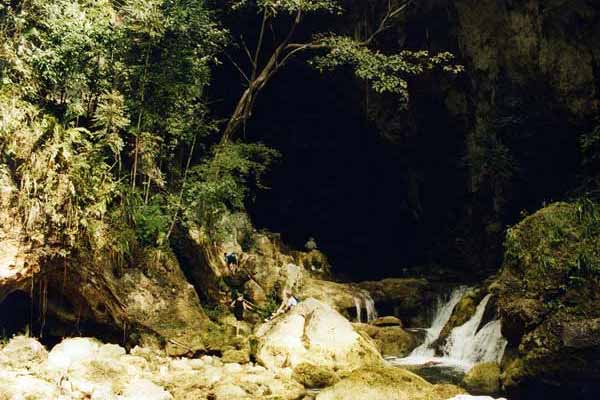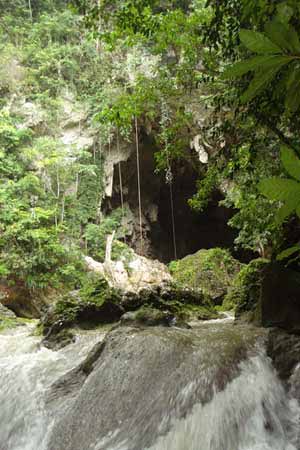Where the Water Enters the Earth: A Maya Wet Cave in Belize

Blue Creek is a small village of only a few hundred Kekchi and Mopan Mayans. As in most Mayan villages in Belize, families tend small farms and live simply. Unlike most Mayan villages, Blue Creek has "Hokeb Ha," which means "where the water enters the earth."
Bruno, a German expat, was to be my guide of Blue Creek. I had no idea what that actually entailed - other than I figured I would need my swimming suit. Bruno reminded me of a friendly, gentle Indiana Jones - with less hair. He drove us down one of Belize's four highways in his air-conditioned Land Rover. The SUV took a right out of modern-day civilization and a left into an ancient adventure.
Near a place where a group of women had gathered on the side of the road to sell jippi jappa baskets, hand-woven from palm leaves (an ancient tradition), Bruno parked the car in a clearing. "Here we are," he announced. "We'll be hiking about a half hour, cross the river a few times, lots of tree roots, but no climbing," he assured me. "Then, we'll be at the mouth of the cave."
Behind the Mayan women and through a patch of jungle was a river so aqua it looked like it had been dyed with blue coloring #6. I dutifully followed Bruno up a small path alongside the river until we came upon a swimming hole. Belizean families were lounging and talking around coolers filled with Belikin beer. Parents watched their children jump into the clear water from a rope swing. One man called out to Bruno in a what-are-you-thinking tone, "You're taking her into the cave?"
As we walked on, Bruno explained to me, "Locals don't like to go into the cave. The ancient Maya believed it was a gateway to the underworld, a sacred place only shamans and priests were allowed to enter. Archaeologists have found ceramics and an altar inside."
He went on, "The cave might seem a little spooky, but it's nothing to be afraid of. Maybe the occasional spider. But don't worry, I have a headlamp for you." Then he added, "You're a strong swimmer, right?"
Headlamp? Underworld? I imagined Blue Creek Cave as a small cave near a creek. I thought we would do a little light climbing, maybe see some birds and then go swimming. I was wrong.

Bruno and I continued hiking into the forest, spotting the occasional empty researcher's shack. We waded into the river and started climbing slippery, moss-covered rocks. The water was cool and to my sweat-soaked skin it felt refreshing. I navigated through pools of fresh water and over boulders the size of the research shacks. Then, I saw it: Blue Creek Cave. Hokeb Ha. Enormous, gaping, and dark, it really did look like a gateway to the underworld.
"If you have to pee, I recommend you find a rock now, I don't like visitors peeing in the cave itself." Bruno waited patiently while I found a semi-private rock to use as both bathroom and changing room. I was under-prepared in just a bikini, since I had expected this trip to be little more than a quick swim. Had I known it would be half a mile's swim in a sunless cave, with no place to walk, sharp rocks, and water depths over my head, I'd have worn a protective shirt and water shoes. My excitement would have to keep me warm.
Bruno was waiting for me with my life-vest and headlamp. "Even if you're a strong swimmer, wear the life-vest, it will keep you warm," he advised. "If we go in and you get cold or scared, we can turn around. This is for fun, not to push yourself."
I jumped into the water.
Panic and adrenaline coursed through my veins while I tried not to think about what might be in the dark water under my feet. I took several deep breaths and followed Bruno into the mouth of the cave. Enormous rocks jutted out from the water, part smooth from eons of erosion, part sharp stalagmite. Below me was more cold water, above me was black air, and in front of me was a gaping tunnel reaching back, back, back. The only way to go forward was to swim.
"How far back does it go?" I asked Bruno.
"Several miles," he answered. "I only went to the end once, with a group of researchers. We spent the night. It took us over 24 hours to reach the end and turn around."
The sunlight from the outside world disappeared when we turned the first corner. I switched on my headlamp and saw thousand-year-old stalactites hanging from the cavernous ceiling. Shadows danced off of rock formations. The air smelled damp and old.
Small-talk seemed inappropriate in a place so intimate and sacred. My thoughts were leaning towards curses, bones, and earthquakes. I remembered swimming in Otter Lake where I grew up, telling my little brother that the bodies of Native Americans were resting at the bottom of the deep lake, waiting to float up and grab swimming children. My made-up tale scared him to the point of tears. Karma is a funny thing.
In the distance, I heard the echo of running water. "There's a small waterfall up ahead," Bruno explained.
The waterfall was really only a trickle, but the echo effect amplified the noise. I sat on a rock, pulled my knees to my chest and closed my eyes. Bruno and I clicked off our headlamps. The darkness in the cave was beyond black, darker than a moonless night. Only death could be this dark, I thought. I imagined Maya shamans entering the cave by the light of torches, possibly under the effects of hallucinogenics they consumed to better commune with their gods.
"I think I'm ready to go back," I told Bruno, flicking my headlamp back on.
The first weak light filtering into the cave flooded my body with relief. I took my last breath in the underworld and emerged back into the picturesque jungle, feeling like I had dodged death. On the path back to the Land Rover, Bruno and I encountered a Belizean boy with his father, headlamps in their hands, ready to explore their living history.
I found my fearless guide, Bruno, through the Matador U Road Warriors program. You can contact him at www.suncreeklodge.de.
Amble

